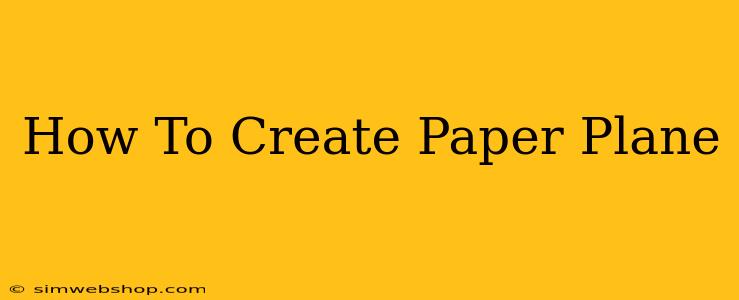Want to build a paper airplane that soars through the air like a champion? Forget those flimsy, pathetic attempts from your childhood! This guide will show you how to create a paper airplane that truly flies, covering everything from choosing the right paper to mastering the crucial folds. Get ready for takeoff!
Choosing Your Paper: The Foundation of Flight
The right paper is paramount for a successful paper airplane. Don't just grab the first scrap you find!
-
Weight: Slightly heavier paper (around 20lb-24lb printer paper) generally provides better stability and flight characteristics. Too light, and your plane will be flimsy and easily affected by wind. Too heavy, and it'll plummet to the ground.
-
Texture: Smooth paper is your best friend. Avoid heavily textured or patterned paper, as the inconsistencies can disrupt airflow and impact flight performance.
-
Size: A standard 8.5" x 11" sheet of paper is perfect for most designs.
The Classic Dart Design: A Step-by-Step Guide
This design offers a great balance between ease of construction and impressive flight capabilities.
Step 1: Fold in Half and Unfold
Begin by folding your paper in half lengthwise, creasing sharply, then unfolding. This creates a central crease that's crucial for subsequent folds.
Step 2: Fold the Top Corners to the Center Crease
Fold each top corner down to meet the center crease. Make crisp folds!
Step 3: Fold the Top Flaps Down Again
Fold the top flaps down again, towards the center crease, but this time, make the folds slightly smaller than the previous ones.
Step 4: Fold the Airplane in Half
Fold the entire plane in half along the original center crease, with the flaps on the inside.
Step 5: Fold the Wings
This is where you'll adjust the plane's flight characteristics. Fold down the wings at an angle. Experiment with different angles – a sharper angle will result in a shorter, tighter flight, while a wider angle will produce a longer, gliding flight. The sweet spot is often around 45 degrees.
Step 6: Fine-Tuning Your Design
- Wingtips: Slightly curving up the wingtips can improve stability and distance.
- Fuselage: Adjusting the angle of the fuselage (the body of the plane) can also affect flight performance.
Beyond the Basics: Exploring Other Designs
Once you've mastered the classic dart, explore more advanced designs! There are countless paper airplane patterns available online, offering diverse flight characteristics and levels of complexity.
Mastering the Art of Throwing
Even the best-designed paper airplane will fail if thrown incorrectly. Here are some tips for optimal flight:
- Grip: Hold the plane firmly, but gently, by the wings.
- Throwing Motion: Use a smooth, overhand motion, like throwing a javelin. Avoid throwing too hard or too softly. Find the perfect balance!
- Angle: Experiment with different release angles to find what works best for your design.
Troubleshooting Common Problems
-
Plane Nosedives: Your wings might be too short or the angle too sharp. Try adjusting the wing angle or lengthening the wings slightly.
-
Plane Doesn't Glide: Your wings might be too wide or the fuselage not aerodynamic enough.
Conclusion: Soar to New Heights!
With a little practice and patience, you'll be building and flying paper airplanes like a pro. Remember, experimentation is key. Don't be afraid to try different designs, adjust the folds, and perfect your throwing technique. Happy flying!

